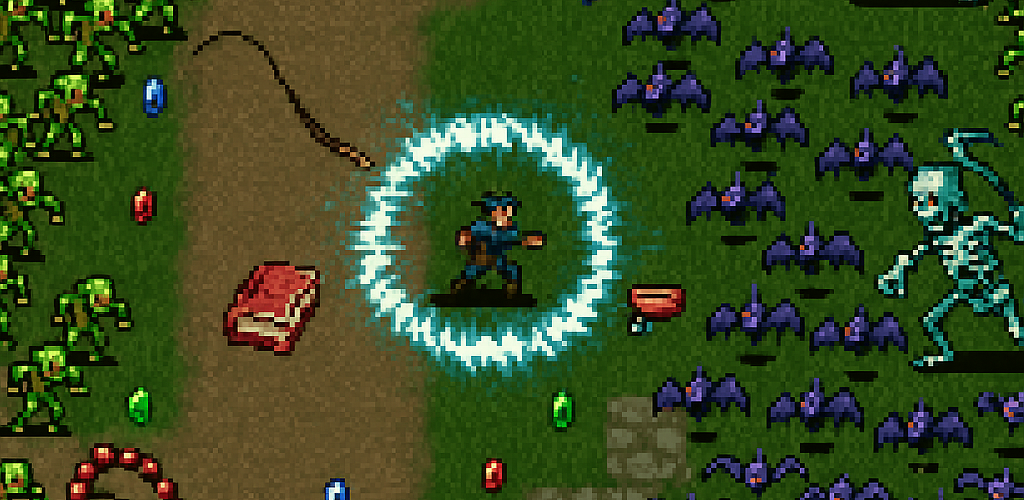Vampire Survivors Review – Minimalist Chaos or Masterpiece?

When Vampire Survivors first appeared in late 2021, few anticipated the storm it would unleash across the indie gaming world. With a pixelated art style, basic controls, and an unassuming $5 price tag, the game looked like just another retro-inspired novelty. But by 2025, it has become a cultural phenomenon, spawning console ports, DLCs, imitators, and even award nominations. Poncle, the game’s developer, didn’t just create a successful indie game—he reshaped how simplicity could drive innovation. Vampire Survivors doesn’t overwhelm with visuals or narrative complexity. Instead, it hooks players with one question: How long can you survive the chaos?
A Simple Premise, Ruthless Execution
Vampire Survivors sets the stage with stark minimalism. Players choose from a growing list of characters, each starting with a unique weapon. Once inside a stage, the character automatically attacks while the player navigates hordes of increasingly dense monsters. There’s no jumping, no aiming, and no special moves. Only movement and survival matter.
That simplicity, however, hides surprising depth. Enemies spawn in overwhelming numbers, forming waves that surround and suffocate unless the player builds a strong offensive synergy. The real-time roguelike gameplay relies heavily on decision-making and positioning. Every level becomes a 30-minute countdown to survival, where success hinges on the combination of weapons, upgrades, and the player’s ability to outmaneuver thousands of enemies.
Addictive Core Loop
Vampire Survivors shines in its core gameplay loop. Players pick up experience gems, level up rapidly, and select upgrades for their weapons and passive bonuses. These small upgrades quickly snowball into screen-clearing combinations. Garlic can create an area-of-effect barrier. The Bible spins around the character, creating temporary safety. The Axe arcs upward and falls down, while the Lightning Ring zaps random enemies. Evolve these weapons with the right pairings, and they transform into devastating machines of destruction.
No two runs feel identical. Randomized upgrades force players to adapt. A failed strategy becomes a learning opportunity, urging experimentation in the next attempt. The sense of progression hooks immediately. Even a short, failed run contributes gold that unlocks new characters, weapons, or perks. This constant forward motion removes frustration and replaces it with curiosity.
Chaos as Design Language
Poncle embraced chaos as a visual and gameplay philosophy. By the 15-minute mark in any run, the screen transforms into a tornado of pixelated projectiles, flinching monsters, and collectible loot. Yet, the game never becomes unmanageable. Every bullet, every enemy, and every power-up remains visible. Clever contrast and particle control prevent the visuals from becoming pure noise.
At its most intense, Vampire Survivors delivers a hypnotic rhythm. The screen floods with motion, the soundtrack crescendos, and the player enters a trance-like state. There’s no pause, no breath—just movement and carnage. The minimal UI helps maintain immersion, and the absence of on-screen distractions contributes to the game’s hypnotic flow.
Pixel Art with Purpose
Vampire Survivors won’t win awards for visual fidelity. Its pixel art borders on crude, intentionally evoking early 90s gaming aesthetics. Yet, that choice enhances the game’s chaotic identity. Enemies come in droves, so high-resolution graphics would likely obscure visibility and slow performance. The simplistic style, instead, provides clarity and efficiency. Every sprite serves gameplay first.
The environments lean into gothic and horror themes. Graveyards, libraries, and cursed forests evoke old-school Castlevania vibes. That connection doesn’t end with visuals—several character names, weapons, and enemy types reference classic horror games and films. These nods feel deliberate and respectful, celebrating the genre without relying on nostalgia alone.
Sound Design and Music
Sound plays a crucial role in the experience. Each weapon produces distinct audio feedback. The whip cracks. The Bible hums with rotation. The magic wand shoots a satisfying zap. These sounds signal weapon effectiveness and rhythm, adding to the kinetic satisfaction of combat.
The background music intensifies over time. Each stage features a unique track that escalates as the waves increase. The tension in the soundtrack matches the progression curve. As the timer approaches 30 minutes, and death itself prepares to appear, the soundtrack crescendos with urgency. Vampire Survivors understands how to use sound to maintain momentum.
Content and Replay Value
Poncle ensured that Vampire Survivors never runs out of content. New characters, stages, power-ups, and secrets continue to arrive with updates. The game includes a bestiary, collection log, arcana modifiers, relics, and hidden achievements. Completing a 30-minute run on one stage only scratches the surface.
The Legacy of the Moonspell and Tides of the Foscari DLCs expanded the universe further. These expansions added new maps, characters, and weapon evolutions, pushing the game’s systems to even greater heights. Players received both depth and breadth with each addition, and the DLCs retained the base game’s affordability and polish.
The inclusion of local co-op brought another layer to the experience. Two players can now face the chaos together, turning an already frantic screen into a shared gauntlet of coordination and strategy. The cooperative mode preserved the core challenge while enhancing the social dimension.
Performance Across Platforms
Initially a PC-exclusive title, Vampire Survivors now thrives across multiple platforms. Xbox, Nintendo Switch, and even smartphones host this tiny juggernaut. The game runs smoothly on low-spec devices thanks to its minimal graphical requirements. On mobile, the intuitive swipe controls replace keyboard input without breaking the experience.
Poncle optimized each version thoughtfully. Load times remain fast, and the core gameplay never suffers from lag or frame drops, even when the screen floods with hundreds of enemies. The console versions support controller input seamlessly, and the cloud save functionality ensures cross-platform continuity for dedicated fans.
Criticism and Room for Growth
No game escapes criticism. Vampire Survivors, despite its brilliance, shows some flaws. The minimalist art style, though functional, can fatigue the eyes during long sessions. Some power combinations feel overpowered, reducing the need for diverse builds in later stages. Once players unlock all content, the motivation to return diminishes unless new content arrives.
The lack of a traditional narrative also alienates players seeking a story-driven experience. Vampire Survivors tells its story through mechanics, not cutscenes or dialogue. That design choice works for most but may disappoint players who crave character development or lore.
Final Verdict
Vampire Survivors delivers one of the most compelling gameplay experiences of the decade. It takes a minimalist foundation and constructs a masterpiece of action, strategy, and progression. Poncle transformed a simple prototype into a genre-defining title by focusing on what matters most: fun.
The game doesn’t chase graphical trends or cinematic storytelling. It builds chaos with precision, balance, and creativity. Vampire Survivors proves that a great game doesn’t need complexity—it needs clarity of vision and execution. In a gaming landscape crowded with bloated AAA experiences, this indie gem stands tall, armed only with garlic, holy water, and relentless charm.













